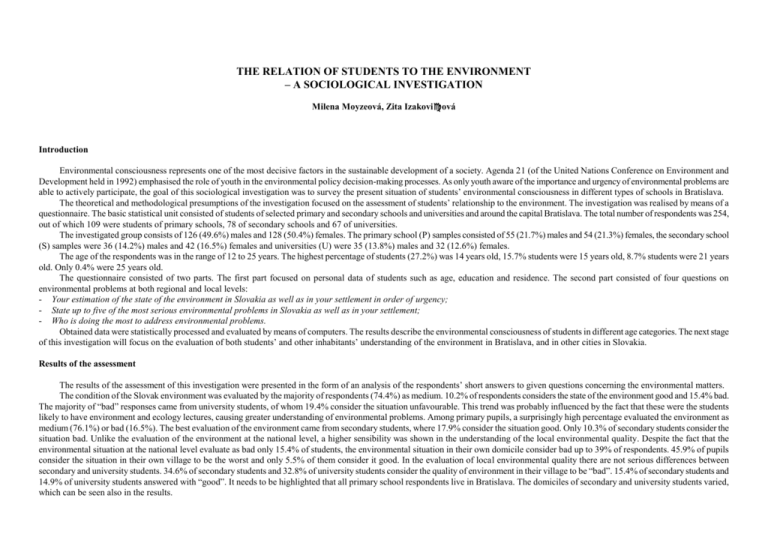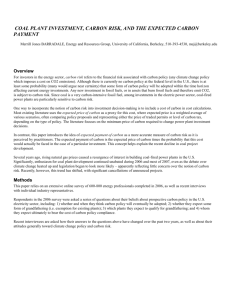The Relation of Students to the Environment - a
advertisement

THE RELATION OF STUDENTS TO THE ENVIRONMENT – A SOCIOLOGICAL INVESTIGATION Milena Moyzeová, Zita Izakoviová Introduction Environmental consciousness represents one of the most decisive factors in the sustainable development of a society. Agenda 21 (of the United Nations Conference on Environment and Development held in 1992) emphasised the role of youth in the environmental policy decision-making processes. As only youth aware of the importance and urgency of environmental problems are able to actively participate, the goal of this sociological investigation was to survey the present situation of students’ environmental consciousness in different types of schools in Bratislava. The theoretical and methodological presumptions of the investigation focused on the assessment of students’ relationship to the environment. The investigation was realised by means of a questionnaire. The basic statistical unit consisted of students of selected primary and secondary schools and universities and around the capital Bratislava. The total number of respondents was 254, out of which 109 were students of primary schools, 78 of secondary schools and 67 of universities. The investigated group consists of 126 (49.6%) males and 128 (50.4%) females. The primary school (P) samples consisted of 55 (21.7%) males and 54 (21.3%) females, the secondary school (S) samples were 36 (14.2%) males and 42 (16.5%) females and universities (U) were 35 (13.8%) males and 32 (12.6%) females. The age of the respondents was in the range of 12 to 25 years. The highest percentage of students (27.2%) was 14 years old, 15.7% students were 15 years old, 8.7% students were 21 years old. Only 0.4% were 25 years old. The questionnaire consisted of two parts. The first part focused on personal data of students such as age, education and residence. The second part consisted of four questions on environmental problems at both regional and local levels: - Your estimation of the state of the environment in Slovakia as well as in your settlement in order of urgency; - State up to five of the most serious environmental problems in Slovakia as well as in your settlement; - Who is doing the most to address environmental problems. Obtained data were statistically processed and evaluated by means of computers. The results describe the environmental consciousness of students in different age categories. The next stage of this investigation will focus on the evaluation of both students’ and other inhabitants’ understanding of the environment in Bratislava, and in other cities in Slovakia. Results of the assessment The results of the assessment of this investigation were presented in the form of an analysis of the respondents’ short answers to given questions concerning the environmental matters. The condition of the Slovak environment was evaluated by the majority of respondents (74.4%) as medium. 10.2% of respondents considers the state of the environment good and 15.4% bad. The majority of “bad” responses came from university students, of whom 19.4% consider the situation unfavourable. This trend was probably influenced by the fact that these were the students likely to have environment and ecology lectures, causing greater understanding of environmental problems. Among primary pupils, a surprisingly high percentage evaluated the environment as medium (76.1%) or bad (16.5%). The best evaluation of the environment came from secondary students, where 17.9% consider the situation good. Only 10.3% of secondary students consider the situation bad. Unlike the evaluation of the environment at the national level, a higher sensibility was shown in the understanding of the local environmental quality. Despite the fact that the environmental situation at the national level evaluate as bad only 15.4% of students, the environmental situation in their own domicile consider bad up to 39% of respondents. 45.9% of pupils consider the situation in their own village to be the worst and only 5.5% of them consider it good. In the evaluation of local environmental quality there are not serious differences between secondary and university students. 34.6% of secondary students and 32.8% of university students consider the quality of environment in their village to be “bad”. 15.4% of secondary students and 14.9% of university students answered with “good”. It needs to be highlighted that all primary school respondents live in Bratislava. The domiciles of secondary and university students varied, which can be seen also in the results. 104 Milena Moyzeová, Zita Izakovi_ová The next group of questions was devoted to the typical problems in Slovakia; 46 problems were specified at a national level and 47 at a local level. At a national level the top five environmental problems counted for 50.4% of all respondents, while at a local level the top five responses counted only 32.3%. At a national level the following most important environmental problems were: air pollution - 17.7% - water pollution - 12.8% - waste - 12.0% - traffic - 7.8% - deforestation - 6.0% - others - 43.6%. Secondary students placed more importance to the problem of high industry concentration in urban areas (8.0%), while university students were concerned with soil contamination (5.3%). At a national level as most important environmental problems were described: - air pollution - 16.6% - waste - 14.0% - traffic - 10.1% - aesthetics - 9.2% - water pollution - 8.8% - others - 41.3%. 12.1% of primary and 7.9% of secondary students on evaluating the quality of local environment cited the importance of the lack of green vegetation, while 4.1% of university students were concerned with the noise pollution. In analysing institutions involved in solving environmental problems, all three categories gave non-governmental organisations the dominant position. Up to 70.9% respondents listed non-governmental organisations as the main institutions involved in the care of environment. In second and third place are citizens and municipalities with 22.8% and 10.2%, respectively. Very little acknowledgement was given to the government and the National Council. The National Council appeared 3.1% of the time and government, 2.8%. It should be noted, that some respondents mentioned two or three institutions, which may partially influence the final results, but not to such a scope which would significantly change the ranking of individual institutions. Evaluating these results according the type of school yields some differences. 44.0% of primary pupils valued, besides the non-governmental institutions, the role of citizens themselves in the environment care, while secondary students placed more importance the municipality with (11.5%) than on the citizens themselves (7.7%). Among university students the municipality was listed 20.0% of the time and parliament in 7.5% of surveys. With respect to the analysis of priority of the problems that society needs to solve, 27.8% of respondents mentioned health problems as the most urgent. 19.0% of respondents mentioned political problems, 18.7% ecological and 18.3% economical. 12.3% of respondents considered social problems most urgent and only 4.0%, educational problems. Thus, using a combination of frequency and ranking of importance, the following hierarchy of problems emerges: health, ecological, social, economical, political and educational. Conclusion The environmental consciousness of students from different types of schools might be considered as satisfactory. University students most understand environmental problems. This is influenced by their age, education and experience. A good level of environmental consciousness was found among primary and secondary schools, even though not all investigated schools provide environmental education in their academic programs. Differences between classes of students were mainly in the hierarchy and range of environmental problems on a local and national level. Detailed characteristics of individual parameters are given in enclosures. References AGENDA 2l, l992: United Nations Conference on Environment and Development. Rio de Janeiro (United Nations), A/Conf. l5l/ 4. HRN_IAROVÁ, T., et al. 1997: The Ecological Carrying Capacity: Methodology and Application on 3 Target Areas, Part I. - IV. Ecological project, ME SR Bratislava, ILE Bratislava. The Relation of Students to the Environment – a Sociological Investigation 105 SCHOOLMASTER, A. F. 1995: Methodological Issues in Using Survey Research Techniques to Estimate Sociological Carrying Capacity. Acta Environmentalica Universitatis Comenianae, Bratislava, 4-5, 31-37 pp. WESTMAN, W. E. 1984: Ecology, Impact Assessment and Environmental. 106 Milena Moyzeová, Zita Izakovi_ová The Relation of Students to the Environment – a Sociological Investigation 1 - waste 2 - air pollution 3 - water pollution 6 - traffic 10 - forest cut 13 - soil pollution 22 - high concentration of industry in towns 107 108 Milena Moyzeová, Zita Izakovi_ová 2 - waste 5 - water pollution 8 - traffic 9 - noise 11 - lack of vegetation 15 - air pollution 16 - aesthetics The Relation of Students to the Environment – a Sociological Investigation 109 110 Viera Rosová G - government P - parliament C - citizen Total order of Urgency 1. healt 2. ecological 3. social 4. economic 5. political 6. educational KA - communal administration NO - non-governmental organizations







